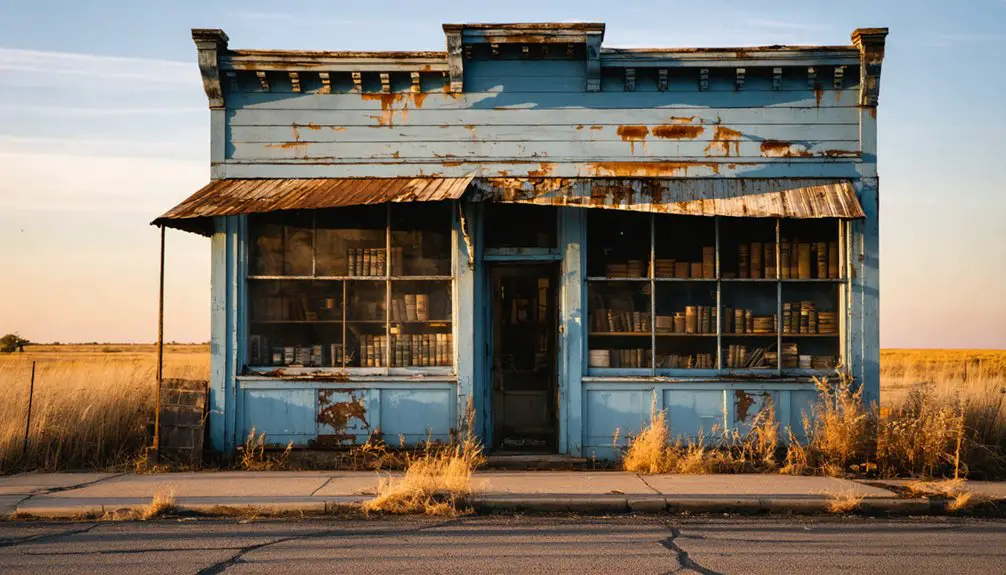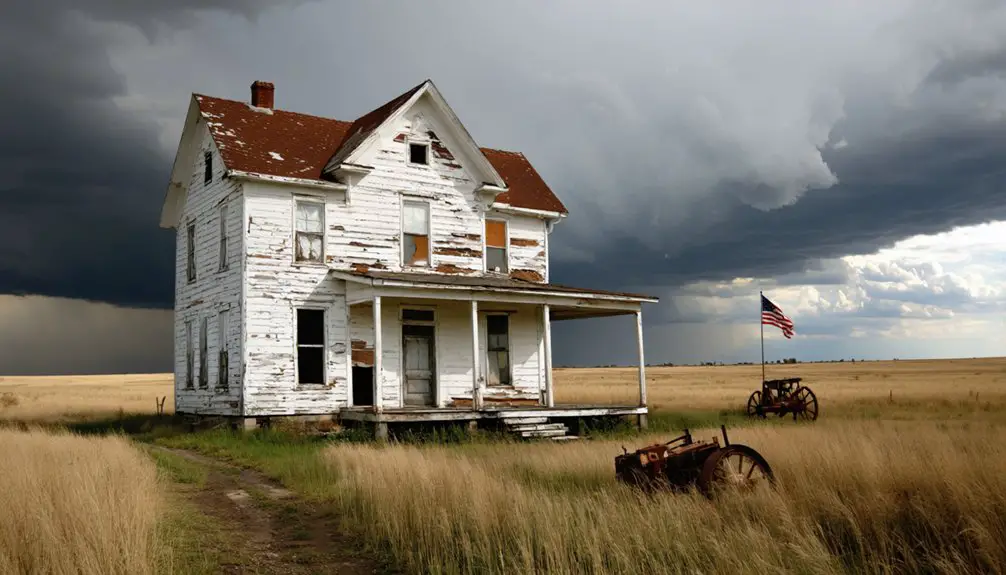You’ll find Geneva’s ghost town remains in Allen County, Kansas, where ambitious settlers from New York and Michigan united in 1857 to build their prairie dream. While they planned for 300 families, only 75 pioneered this Neosho River settlement, establishing a sawmill, store, and academy. The town’s isolation from vital railroad connections led to its decline, and today, only a five-acre cemetery marks where this hopeful frontier community once stood. The story behind Geneva’s rise and fall reveals fascinating insights into early American settlement life.
Key Takeaways
- Geneva, Kansas was founded in 1857 by settlers from New York and Michigan, initially planning to establish a community of 300 families.
- The settlement never achieved its population goals, peaking at only 75 families despite having a sawmill, store, and post office.
- The town’s decline was primarily due to missing crucial railroad connections while neighboring communities like Iola and Humboldt prospered.
- The post office’s closure in 1942 marked a significant milestone in Geneva’s transformation into a ghost town.
- Today, only a five-acre cemetery remains as evidence of Geneva’s existence, alongside scattered traces of the original 640-acre settlement.
The Birth of a Prairie Dream: New York and Michigan Settlers Unite
While the American frontier beckoned countless settlers westward in the mid-1800s, Geneva’s story began uniquely with two separate colonies from New York and Michigan joining forces under a shared vision.
Two pioneering colonies, from New York and Michigan, united their dreams to forge Geneva’s distinctive path westward in frontier America.
This cultural collaboration united under the Union Settlement Association, with Ephraim Fisk leading the New York contingent and Merritt Moore heading the Michigan group.
You’ll find their agricultural aspirations reflected in their strategic choice of land – fertile prairie bordered by timber-rich creek banks near the Neosho River.
Together, they planned to settle roughly 300 families in Allen County, Kansas.
The association’s leadership, including Dr. B.L.G. Stone, G.L. Wait, and Rev. G.S. Northrup, envisioned a thriving community complete with a college, sawmill, and extensive farmland spanning at least 640 acres.
The settlement took shape in the summer of 1857 when the first pioneers established their new home in Geneva Township of northwest Allen County.
Among these early settlers was Jonathan H. Spicer, who developed 167 acres of farmland complete with orchards and livestock.
Early Days of Progress: Building a Community
As the Union Settlement Association took root in 1858, Geneva’s pioneers quickly established essential infrastructure along the timber-rich banks between Martin and Indian Creeks.
The community dynamics centered around 640 acres of fertile prairie land, where about 75 families, rather than the anticipated 300, carved out their frontier dreams despite economic challenges. Like many Kansas land booms, the town’s growth was tied to the opening of prairie sections for settlement. Similar to the settlers of Thomas County, who were drawn by free homestead land, these pioneers sought opportunity in the untamed prairie.
- A steam-powered sawmill, built through partnership with L.L. Northrup, became the town’s first major development.
- The establishment of a store and post office by November created a commercial hub.
- A blacksmith shop provided important services for the growing settlement.
- The Congregational Church, first in the county, fostered spiritual and social bonds.
The pioneering spirit of these settlers transformed raw prairie into a bustling community that would serve as an essential railroad station and trading center.
Life in Geneva: Education, Faith, and Commerce
Despite initial plans for a thriving settlement of 300 families, Geneva’s social fabric took shape around roughly 75 pioneering households who established essential community institutions in the late 1850s.
You’d find education at the heart of their aspirations, with the town facing educational challenges as they built a two-story academy in 1866.
The religious significance of Geneva centered on the Congregational Church, founded in 1857 under Reverend Gilbert S. Northrup’s leadership, which served both spiritual and social needs.
Commerce remained modest but crucial, with a steam-powered sawmill, blacksmith shop, and general store supporting daily life.
The post office, established in 1858, connected Geneva to the wider world until 1942, while the arrival of the ATSF railroad in 1912 briefly enhanced the town’s trading capabilities.
The Railroad Years: Trading Hub of Allen County
During the 1870s and 1880s, Allen County transformed into an essential railroad hub with 96 miles of main line tracks crisscrossing its terrain.
You’ll find that Geneva, once poised to become a major trading center, missed its chance at prosperity when it failed to secure crucial railroad connections. Free-state men had originally established Geneva as one of the thriving early communities in Allen County.
- The Missouri, Kansas & Texas Railway established routes across southwestern Allen County in 1870
- The Fort Scott & Wichita railroad cut through Iola by 1880, funded by township bonds
- Branch lines connected smaller towns like Colony and Moran to major rail arteries
- Towns with railroad access, like Iola and Humboldt, flourished with cement factories and commercial growth
The economic impact of lacking rail access proved devastating for Geneva. The discovery of natural gas deposits in the region further emphasized the town’s missed opportunities for industrial development.
While neighboring communities thrived with new transportation options, Geneva’s isolation led to its eventual extinction, overshadowed by railroad-connected towns that attracted commerce and settlers.
Why Dreams Sometimes Fade: Understanding Geneva’s Decline

When you examine Geneva’s ambitious beginnings, you’ll find a stark contrast between the Union Settlement Association’s vision for 300 families and the reality of only 75 families arriving to populate the hopeful colony.
The limited population base couldn’t sustain the planned infrastructure, including a proposed college and robust business district, leaving the settlement perpetually struggling to achieve its foundational goals. This pattern of decline mirrored towns like Empire City, which saw its population of 3,000 residents vanish as mining opportunities dwindled. Much like the town of Dunlap, which experienced a dramatic fall from its peak of 400 residents in the late 1800s to virtual abandonment.
Geneva’s unfulfilled dreams of growth became particularly evident as essential services never materialized, creating a cycle where the lack of development discouraged new settlers, which in turn prevented the town from building the very amenities it needed to thrive.
Population Dreams Vs Reality
While initial settlers envisioned Geneva, Kansas as a bustling community of 300 families spread across 640 acres, the town’s reality fell drastically short of these ambitious dreams.
Despite optimistic population projections reaching 2,000 residents in its early days, settlement challenges quickly emerged, leading to a stark difference between expectations and reality.
- Only 75 families ultimately chose to make Geneva their home.
- By the early 20th century, the population had dwindled to roughly 100 people.
- The closure of the post office in 1942 marked a turning point in the town’s decline.
- Economic opportunities shifted to nearby towns like Iola and Humboldt.
You’ll find it fascinating how quickly dreams can fade. Geneva’s transformation from a promising settlement to a ghost town serves as a poignant reminder of frontier life’s uncertainties. Like many other locations sharing names in Kansas, Geneva’s story is preserved through disambiguation pages that help researchers navigate its historical significance.
Infrastructure Never Materialized
Although Geneva’s founders laid ambitious groundwork for a thriving frontier settlement, the town’s infrastructure plans largely remained unfulfilled dreams on paper.
You’ll find evidence of this in the 640-acre town layout and early establishments like the 1858 post office and steam sawmill on Indian Creek. Yet infrastructure challenges quickly mounted – the promised multipurpose college building never materialized, and the sawmill failed to generate sufficient economic momentum.
Like Arvonia’s promised railroad never materialized, Geneva’s lack of rail connections proved particularly devastating, as neighboring towns with rail access drew away potential settlers and commerce.
Community neglect followed as essential services like fire departments, schools, and local government offices failed to take root. Without sustainable funding or a stable population base, Geneva couldn’t develop the institutional and transportation infrastructure needed for long-term survival.
What Remains: A Ghost Town’s Silent Story
Today’s visitor to Geneva, Kansas will find little evidence of the once-hopeful frontier settlement beyond its five-acre cemetery on the east side of a rural road.
The ghostly remnants of this pioneering community tell silent stories of ambitious dreams that never fully materialized.
Where a thriving town of 300 families was once envisioned, you’ll now encounter:
- An empty prairie landscape where steam-powered sawmills and bustling shops once stood
- The historic Geneva Cemetery, the last tangible landmark of the original townsite
- Former grounds of Allen County’s first Congregational Church, established in 1857
- Scattered traces of the original 640-acre settlement plan, now returned to farmland
The land has reclaimed most physical traces of Geneva, leaving only memories of its brief existence as a frontier community.
Frequently Asked Questions
What Happened to the Original Houses and Buildings in Geneva?
You’ll find the original structures deteriorated and vanished due to abandonment, with no historical preservation efforts to save them. They succumbed to natural decay, weather damage, and eventual removal.
Were There Any Notable Crimes or Conflicts During Geneva’s Active Years?
You’d think a frontier town would have juicy crime incidents, but historical records show Geneva was surprisingly tame. No major historical conflicts or criminal activity were documented during its active years.
How Did Extreme Weather Events Affect Geneva’s Development and Survival?
While you can’t pinpoint a single devastating weather event, the climate impact weakened Geneva’s weather resilience through recurring droughts, floods, and harsh winters that gradually stressed farming and discouraged population growth.
What Native American Tribes Previously Inhabited the Geneva Area?
In this fiercely contested heartland, you’ll find the mighty Kaw Tribe (also called Kanza) dominated the area, while the powerful Osage Nation maintained significant influence nearby, sharing these ancestral hunting and settlement grounds.
Did Any Famous People or Historical Figures Visit Geneva?
You won’t find records of famous visitors to Geneva beyond its founding settlers like Ephraim Fisk and Merritt Moore. The town’s historical significance stems from local leaders rather than celebrity appearances.
References
- https://legendsofkansas.com/geneva-kansas/
- https://freepages.rootsweb.com/~gtusa/history/usa/ks.htm
- https://www.hhhistory.com/2019/05/ghost-towns-of-kansas.html
- https://www.youtube.com/watch?v=alC1wDdSVvg
- http://kansasoakland.blogspot.com/2011/08/ghost-town-of-geneva-kansas.html
- https://cityofgenevany.gov/310/History
- https://www.cityoflakegeneva.gov/322/History
- https://www.ksgenweb.org/archives/allen/history/1901/69.html
- https://fhsuguides.fhsu.edu/kansasheritage/thomascounty
- https://thewanderingpigeon.com/2015/10/03/day-of-kansas-ghost-towns/



